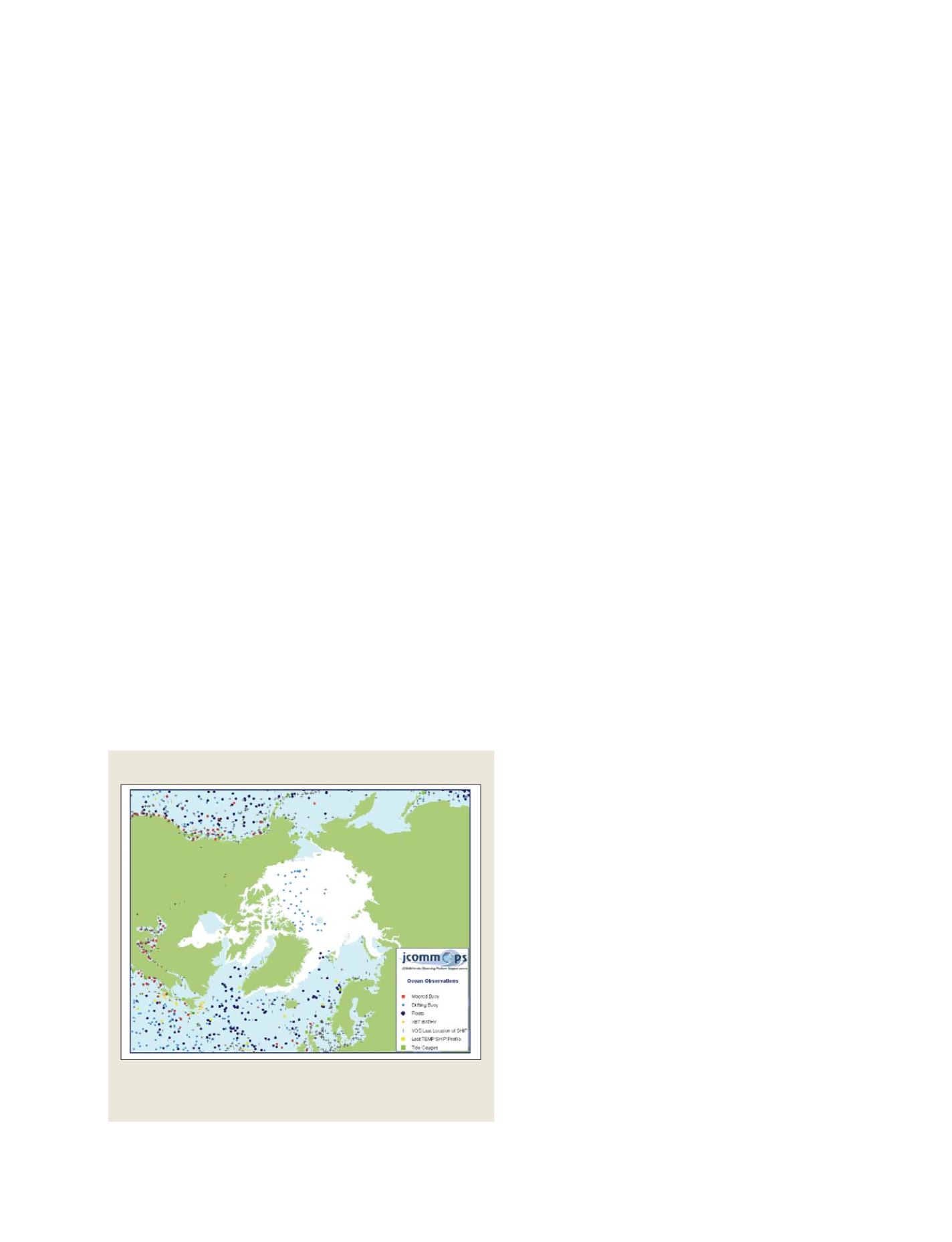

[
] 78
continental shelves. The OTN has been kick-started with a USD35
million grant from the Canadian Foundation for Innovation and is
bringing together international scientists, industry and government in
an effort that could potentially add a biological monitoring component
to the ocean observing system for the first time.
Another gap in the system occurs in polar regions, underneath the
sea ice. An ocean observing scheme for the Arctic Ocean, for example,
is being implemented by the European Commission 6th Framework
Program-funded project DAMOCLES, which includes an extensive
system of floats and gliders exploring the upper ocean, receiving navi-
gation information and communicating their data to satellite via a
net of ice-tethered platforms. One hope is that International Polar
Year 2007-2009 (a scientific programme) will help provide the
impetus to maintain such observations into the future as an arctic
component of the sustained global ocean observing system. The
prospect of filling gaps in our observational capabilities with novel
research and technologies developed in pilot projects such as OTN
and DAMOCLES is extremely exciting.
The value of ocean observations is dramatically increased if they
are brought together as components in a coordinated global system
that serves multiple users.
10
For example, the GLOSS tide gauge
array provides real-time data vital for tsunami warning systems, but
this infrequent use does not alone provide sufficient support to main-
tain the network. It is because local sea level data are also of use for
more quotidian purposes, such as offshore development, routine
marine transport planning and coastal zone management, and
because these data are combinable with other observations, such as
satellite remote sensing altimetry measurements for calibration and
validation, that the tide gauge system is sustainable. Can even more
benefit be extracted from ocean observations by integrating them
still more broadly within a comprehensive system encompassing all
earth observations? In the hope that such integration may add value,
GOOS has accepted responsibility as the ocean component of the
Global Earth Observing System of Systems (GEOSS) and is a found-
ing participating organization in the Group on Earth
Observations (GEO).
The GEO has provided unprecedented political inter-
est in the observation of the Earth. Thanks to GEO,
earth observations were discussed by heads of state at
the G8 summit meetings in Gleneagles in 2005 and
Heiligendamm in 2007, and a third ministerial level
GEO meeting is to be held in Cape Town in November
2007. GEOSS is intended to build on, and add value to,
existing observation systems by coordinating their
efforts, addressing critical gaps, supporting their inter-
operability, sharing information, reaching a common
understanding of user requirements, and improving
delivery of information to users. This is certainly bold
and exciting vision from the top, but how is it working
down in the trenches for the sub-sub-sub-systems that
are actually collecting and disseminating data?
For example, what specific added value would be
derived from sharing protocols for interoperability
between, say, fish population movement observations
off the Pacific Coast of North America, and glacial mass
balance observations in the European Alps? Both are
important, supported by strong communities of scien-
tists and have clear societal benefits, but spending too
much time, money and effort coordinating them is
probably an imbalance of effort and reward.
In fact it is certainly possible to ‘overestimate the poten-
tial of synergies’ as Dieter Zetsche, chief executive of
DaimlerChrysler, stated after announcing the USD15
billion loss associated with the sale of Chrysler, less than
a decade after its merger with Daimler-Benz. The GEOSS
experiment is several years old now and, as was the case
at Daimler-Chrysler, finding specific, tangible, quantifi-
able benefits that owe their existence to this new layer of
coordination, as opposed to constituent observing
systems that were already in place, is not an easy task.
The ocean community potentially has an enormous
amount to gain from the advent of GEOSS, but to do so
we must keep a steady aim on the goal of delivering an
actual earth observing system for society. If not, it
would be all too easy to lose our way in a plethora of
trivial tasks, only to be forced to cut our losses.
Furthermore, oceanographers must remain vigilant to
ensure that this new high-level political exposure and
coordination with non-oceanic observing systems is
indeed adding new value to our existing efforts.
For fifteen years GOOS has been meeting important
needs of the global society. New technologies are being
incorporated and gaps in the system are being filled.
However, existing intergovernmental mechanisms have
enabled surprisingly little progress toward a truly global
systemwith long-term funding commitments. Monitoring
and stewardship of the global oceans is a global responsi-
bility, and GOOS is working with its sponsors in the
United Nations, the Intergovernmental Oceanographic
Commission (IOC) of UNESCO, UNEP and WMO, the
International Council for Science (ICSU), GEO and the
many individual nations that support these groups, to
ensure that our responsibilities are met.
The existing near real time Arctic Ocean Observing System
Near real time GOOS data availability in the Arctic on 23 July 2007 from the
Observing Platform Support Center (JCOMM-ops) of the Joint IOC/WMO
Commission on Oceanography and Marine Meteorology
Source:
www.jcommops.orgGEOSS C
OMPONENTS
– O
BSERVING
S
YSTEMS
















